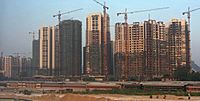
Photo from wikipedia
The quality and scale of urbanization development are the two main aspects in China’s current urbanization process. By measuring and analyzing the level differences in these two aspects, the healthy… Click to show full abstract
The quality and scale of urbanization development are the two main aspects in China’s current urbanization process. By measuring and analyzing the level differences in these two aspects, the healthy development of China’s urbanization and urban–rural integration will be promoted. Based on the quality of urbanization and the scale of urbanization, this paper constructs an evaluation index system for urbanization coordination level. On this basis, this paper analyzes the spatial correlation, spatial difference, and spatial pattern evolution characteristics of urbanization coordination level in 286 sample cities nationwide from 2005 to 2015. Then, by introducing the spatial econometric regression model, this paper discusses the driving mechanism of the spatial and temporal evolution of urbanization coordination level. The results show that: (1) The level of coordination between urbanization quality and urbanization scale shows a strong spatial correlation in space, which is consistent with the actual development status; (2) the level of urbanization coordination shows a trend of evolution from northeast to southwest in the evolution of spatial pattern, but the extent of change is small; and (3) the spatial and temporal pattern of urbanization coordination level is affected by different driving forces, of which internal source is the primary impact factor, followed by administrative level and investment level. In addition, the level of urbanization coordination has a positive spillover effect on the level of urbanization coordination in adjacent areas.
Journal Title: International Journal of Environmental Research and Public Health
Year Published: 2020
Link to full text (if available)
Share on Social Media: Sign Up to like & get
recommendations!